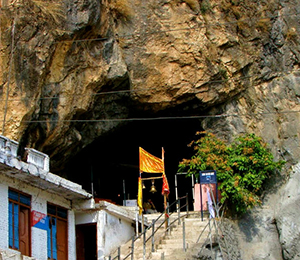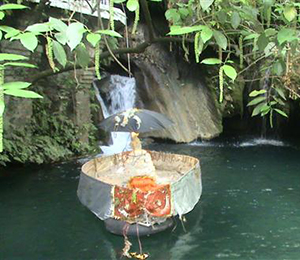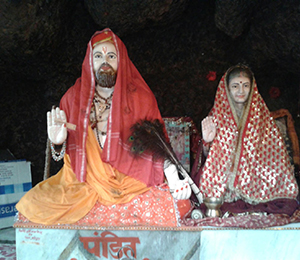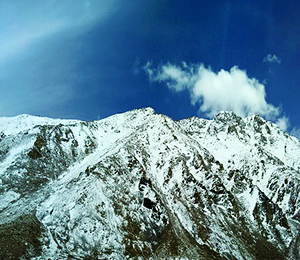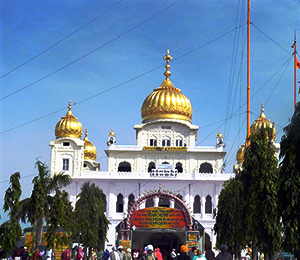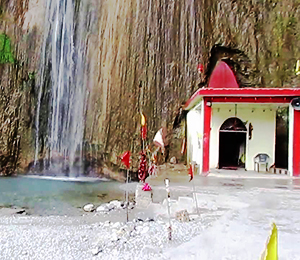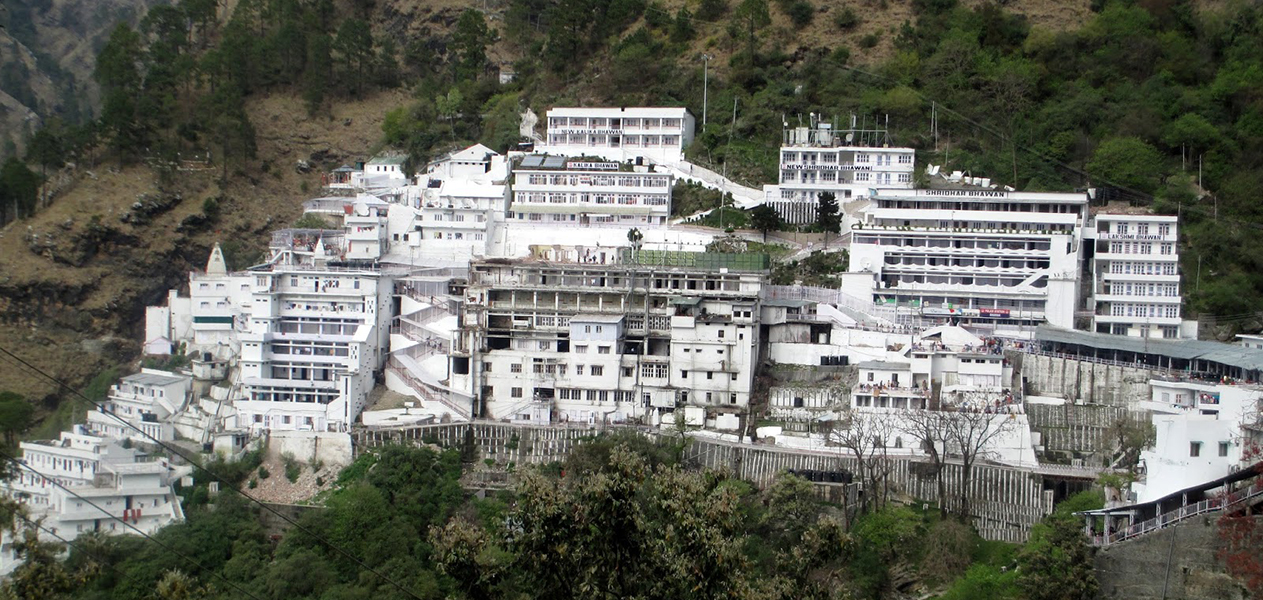
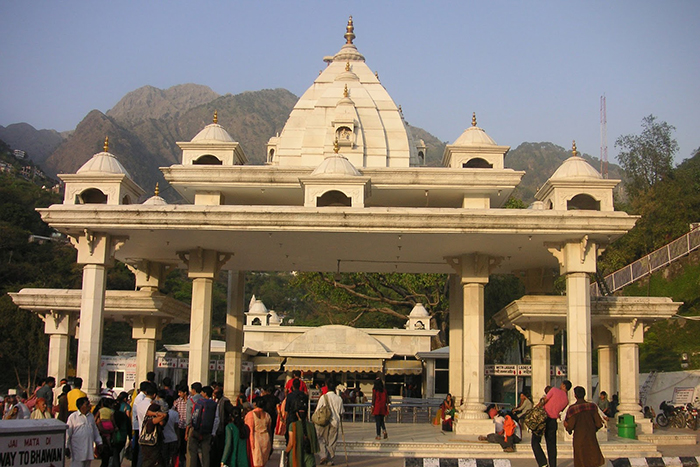
The holy cave shrine of Mata Vaishno Devi is located at a height of 5,300 feet in a beautiful recess of the Trikuta Mountains, forming a part of the lower Himalayas in Jammu and Kashmir.
The journey here takes you through awesome wilderness amidst snow- capped mountains and sprawling forests, to the shrine, sacred and mystical.
Every day of the year scores of devotees ascend steep pathways that cut across the hillside. A common faith among people is that goddess Vaishno Devi sends a 'call' to her devotees; and once heralded, the pilgrim finds himself compelled to march towards the holy shrine of the great goddess. It is believed that a supernatural power seems to draw pilgrims across the mountains, so they climb those great heights, step by step, chanting "prem se bolo, Jai Mata di". Even those who are unused to walking the slightest distances, accomplish the difficult ascent of innumerable stairs. Popular belief holds that anybody who walks the Himalayan trail to Mata Vaishnov Devi's abode to ask for a boon does not return disappointed.
There are many who journey here year after year to pay obeisance regardless of their faith, creed or class, caste or religion, because Mata Vaishno Devi transcends all such artificial barriers. Katra, a small town in the foothills of Trikuta, serves as the base camp to the Mata Vaishnodevi Yatris. The shrine is approachable on foot along a 12 km path from Katra. Every year, nearly 6 million pilgrims visit Mata Vaishnodevi. The shrine has been a beacon of faith and fulfillment to millions of devotees. Popular belief holds that anybody who walks the trail to the goddess abode rarely goes back disappointed. The holy shrine contains the holiest of holy Pindis, manifesting the Mata in three forms Maha Kali, Maha Lakshmi and Maha Saraswati representing Creative, Preservative & Destructive aspect of Mata.
It is said that a man named Sridhar discovered the cave; he lived near Katra and was a devotee of Mata. Sridhar had no children and worshiped little girls. One day Mata appeared in his dream and revealed to him her cave abode, goddess blessed him four sons. Sridhar worshiped at the cave and since then his descendants perform as pandits at the holy cave. It is believed that the Yatra is not complete unless the pilgrim visits Bhairon ka Mandir as well (2.6 km from the main shrine).
Yatris on reaching Katra need to get a Parchi (registration slip) from Shri Mata Vaishno Devi Shrine Board (SMVDSB) counters near the Bus Stand. Counter No.1 for 1 to 9 persons & counter No 2 for 10 persons and above. Counters are from 6 am to11 pm. Pithus, palkiwalas and ponywalas registered with the authorities are available from Katra to Banganga. The rates from Katra shrine and back are fixed as per the weight of luggage and yatri. Yatris are advised to check identities of hired pithu, palkiwala, ponywala and note their numbers/ names in case of any kind eventuality. After darshan, one must not miss trying maalish (Body Massage) of Katra.The maalishwala will loosen your body using different massage methods and a variety of oils for your food taste. Katra is no less than a metro city.The modern Fast Food restaurants fulfil the needs of every yatri-be it Punjabi, Gujarati, Marathi, Bengali, NRI’s or foreigners. The food at Dhabas and Restaurants is equally tasteful and reasonable. In obeisance to Mata, the entire Katra town and nearby areas declared vegetarian and alcohol free.
Katra main bazaar is full of Kashmiri handicraft items, all types of dry bhaints, gift items and other specialties from the region.
As legend goes, more than 700 years ago, Vaishno Devi, a devotee of Lord Vishnu had taken a vow of celibacy. Bhairon Nath, a tantric, using his tantric powers, was able to see her going towards the Trikuta Mountains and chased her. The goddess feeling thirsty at Banganga, shot an arrow into the earth from where water gushed out. Charan Paduka, marked by the imprints of her feet, is the place where she rested. The Goddess then meditated in the cave at Adhkawari. It took Bhairon Nath nine months to locate her, and this cave is called Garbh Joon. She kept 'Veer-Langur' on guard outside the cave and asked him not to allow Bhairon to enter the cave. When Bhairon Nath tried to force an entry to the cave, Veer-Langur offered resistance and a terrific battle started. Vaishno Devi blasted an opening at the other end of the cave with her trident when Bhairon located her.
Thereafter Devi took the form of goddess 'Chandi and beheaded Bhairon Nath, whose skull was flung up the mountain by the force of the blow and fell at a place now known as Bhairon Ghati. Beheaded Bhairon now prayed to Mata for mercy and was granted a boon of liberation. She said, "My devotees will visit your place after they have come to me for 'darshan'." The desires of devotees will be fulfilled, if they visit your place. A temple has been constructed at the spot where Bhairon's head fell. Accordingly, the pilgrims visit Bhairon temple after offering prayers at Mata's cave.
It is mandatory to obtain a slip from the Yatra Registration Counter at the Tourism Reception Centre, Katra Bus Stand, without which, crossing of Banganga check-post is not permitted. The yatra begins at Katra and pilgrims have to cover 13 km. of terrain on foot to reach the shrine. At Banganga, a kilometer away from the starting point is a security check post. After 6 km of trekking, you reach Adhkawari, the holy cave where Mata meditated for nine months. Most devotees catch a breath at Sanji Chatt after 9.5 km of walking. Accommodation is also available at this place. The shrine is just 3.5 km away. By showing your yatra slip at the registration office at the Bhawan, you are given a number, which will determine your place in the queue for darshan.
At the Bhawan there is provision for bathing, and for keeping your belongings in safe custody, as leather items are not permitted. Blankets are also available at a refundable deposit.
Prasad, "chunari" and coconuts can be bought from shops situated at the entrance of the Bhawan. In case of overcrowding, you might have to wait patiently in a queue according to your batch number. Before entering the cave, the coconut has to be deposited against a token. The whole valley reverberates with the chanting of "Jai Mata di".
According to legend, the boulder at the mouth of the holy cave is the petrified torso of Bhairon who was granted divine forgiveness by the benevolent Mata in his dying moments. Inside the cave, there are three natural pindis of Maha Saraswati, Maha Lakshmi and Maha Kali which represent the creative, preservative and destructive aspects of the divine energy images of three deities - Mahakali, Maa Saraswati and Maa Lakshmi. The holy Ganga's cold and crystal clear water washes the lotus feet of the Mata's 'Pindian'. Previously the shrine had only one natural entry cave, but now two more exit caves have been constructed. Remember to collect your coconut here.
The whole route is swept and cleaned several times every day. Shelters and cafeterias are set up throughout the route. Pure vegetarian food is available at these outlets. Price charts are exhibited prominently. Drinking water has been made available all along the route, with water coolers and storage facilities. Public utilities with automatic flushing systems are located all along the track and at the Bhawan. Qualified doctors are available round the clock at the Primary Health Centre, Katra, Adhkawari and Bhawan. The Evening Clinic at Katra Bus Stand is open from 2 pm to 8 pm.
The Vaishno Bhojnalyas in and around Katra market provide delicious meals from early morning to late evenings. At the sweet shops one can have a quick breakfast of cholla puri or milk with jalebi. There are some good fast food restaurants like JKTDC Jewels, Hills and New Durga near the bus stand. Most of the hotels have self-contained restaurants where all type of Indian and continental meals are provided. Free langars right from Banganga up to the Holy cave are also available. The Bhojnalyas enroute provide meals throughout day and night. The SMVDSB restaurant at the bhawan is hygienic and economical too.
Yatri Niwas is managed by the Shrine Board. Various private hotels are also available, the room rent ranging from Rs.300/- per day to Rs.3000/- per day. At Katra, accommodation is available in A/C and non-NC hotels as well as budget hotels, guest houses, dharamshalas. The hotels are located from the entrance point of Katra right up to Chintamani Mandir. Accommodation is also available around the old bus stand area and on the Kashmir-Tikri race. The SMVDSB’s well maintained sarais and houses on the entire route of the shrine and at the Bhawan should be booked in well advance.
